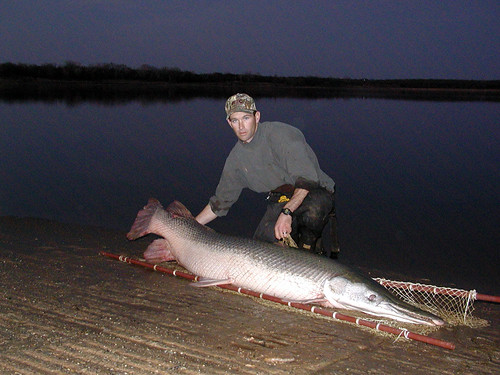Sean Chatham, of Ardmore, pulled in a 184-pound, 3-ounce alligator gar Feb. 25 from the Red River in Love County, establishing a new state record.
Chatham snagged the monstrous fish about 2 p.m. using a stainless steel leader and 25 pound test line.
“We try to go after the big ones, but when I saw how big this one was I was really surprised. I fought the fish for about 35 minutes before it got into some shallow water near the bank. When it did, I jumped on it and tried to keep it from making another run into deep water,” Chatham said.
The record-breaking alligator gar measured seven feet, eight inches long and was an impressive three feet, two inches in girth.
Chatham's fish broke the previous alligator gar record by four pounds. Deryl Landers set the previous record a 180-pound fish also caught from the Red River in 2002.
Chatham, an avid gar angler, is helping the Oklahoma Department of Wildlife Conservation in a research project to learn more about these unusual fish. Each time he catches an alligator gar he places a tag near the dorsal fin before releasing the fish. This allows researchers to learn more about the gar population, seasonal movements and general life history.
"Alligator gar are truly unique fish and the Red River is one of the few places left where they can be found," said Kim Erickson, chief of fisheries for the Oklahoma Department of Wildlife Conservation. “We really appreciate the help that anglers like Chatham have provided on this ongoing study."
Anglers across Oklahoma are also an important part of the study. They are funding the project by buying fishing licenses, as well as purchasing sporting goods. Sporting goods manufacturers pay a federal excise tax for items such as firearms and fishing lures. These revenues go into the Sport Fish and Wildlife Restoration Program, which distributes millions of dollars to worthy conservation projects throughout the nation. The study is being conducted through the Oklahoma Cooperative Fish and Wildlife Research Unit at Oklahoma State University in Stillwater.
Those interested in seeing a big alligator gar for themselves will soon have the opportunity at the Oklahoma Aquarium in Jenks. Aquarium personnel and Wildlife Department fisheries biologists recently collected two gar (one weighing nearly 100 pounds and the other tipping the scales at 70 pounds) from the Red River. The pair will go on public display after a quarantine period.
For a complete list of record fish and the procedures regarding certifying state record fish, consult the “2006 Oklahoma Fishing Guide.” If you think you may have hooked a record fish it is important that you weigh the fish on an Oklahoma State Department of Agriculture certified scale and a Wildlife Department employee verifies the weight.






